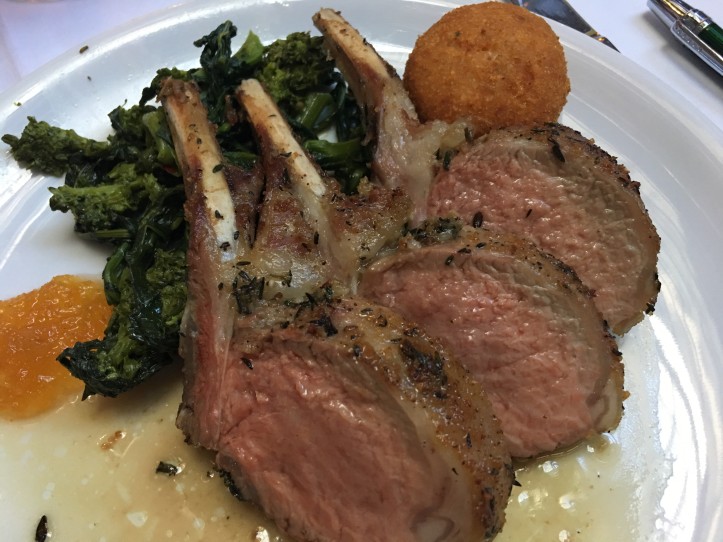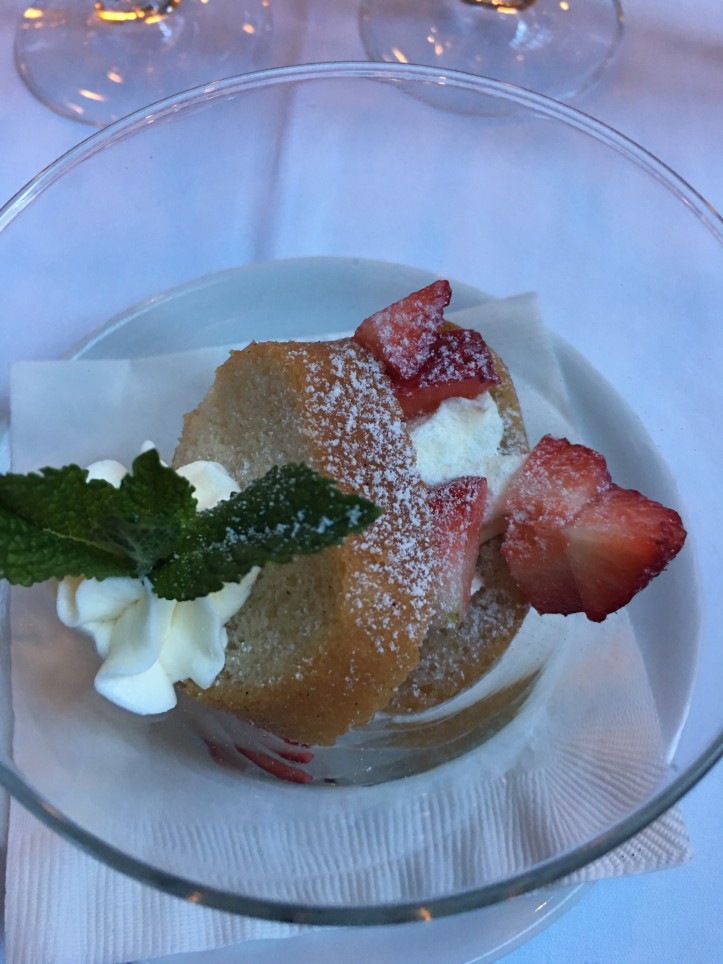
About a year ago I had the pleasure of attending a luncheon at Il Gattopardo, a swanky restaurant across the street from the Museum of Modern Art in New York City. The reason? To welcome Ilaria Petitto and the wines made on her family’s property, Donnachiara Montefalcione.


At the time I was familiar with the wines of Campania in general but knew almost nothing about those from the local region of Irpinia, situated an hour’s drive inland from the famous Amalfi Coast and the bustling city of Naples. I came away from that lunch with an unbridled appreciation for the land, its wines and, above all, its people.
Needless to say I was very pleased to be invited to another lunch a few weeks ago – same wines, same place – and to learn what was new with Ilaria and Donnachiara.
Where Is Irpinia?

Irpinia occupies the Apennine foothills around the town of Avellino and is named for the ancient Hirpini tribe which used to live here; both names reference the local species of wolf (hirpus) that once roamed and hunted in the forests.
Vines are grown at elevation and benefit from the climate, which is more continental (cold winters, hot summers, large diurnal temperature shifts) than in the coastal areas. Soils are a mix of chalk and clay layered over a few centuries’ worth of ash from once-active volcanoes. Each of these factors adds complexity to the wines made here – in Donnachiara’s case, from native grape varieties like Fiano, Falanghina, Greco di Tufo, and Aglianico. For such a southerly region, the wines are remarkably fresh and acidic, keeping them lively on the palate and increasing their ability to age gracefully.
Five Generations of Women at the Helm
Although the modern winery was built in 2005, the family’s history in Campania traces back several generations to Ilaria’s great-grandmother Chiara – the original Donna Chiara for whom the winery is named. Fiercely protective of her family’s land, Donna Chiara was instrumental in saving it from the ravages of World War II. When her husband, a surgeon in the Italian Red Cross, left home to care for wounded soldiers, Donna Chiara remained on the property she had loved as a child, protecting it as her parents had done during World War I.

And so it progressed, this love of the land, from one strong woman to another, from Donna Chiara to her granddaughter, and then to her daughter, Ilaria who, by the way, has a young daughter of her own named Chiara; she represents the fifth generation.
Tasting the Wines

2017 Donnachiara Beneventano Falanghina IGT (about $13 retail)
100% Falanghina from the heart of Taburno. Grapes are fermented in stainless steel under temperature-controlled conditions. No malolactic fermentation; no oak aging. Color is pale straw and aromas are dominated by lemon and chalk, with peach and apricot emerging after some time in the glass. Flavors are citrus, ripe stone fruit, and a little melon on the finish. This wine is crisp and refreshing; perfect as an aperitivo on a warm summer day.

2016 Donnachiara Beneventano Falanghina IGT “Resilienza” (about $24 retail)
Another 100% Falanghina, this wine is made from grapes manually harvested from higher-elevation sites during the early morning hours to preserve aromas and acidity. Grapes undergo cryomaceration (42-46 degrees F) and are fermented in stainless steel. No malolactic fermentation or oak aging, but it did spend some time on the lees.
It is deeper in color than the first wine, more gold than lemon. There’s a little funk on the nose, maybe a little yeasty note; then there is beeswax, ripe golden apple and acacia flowers. On the palate it is a balanced mix of earthy and fruity flavors, a texture perfectly hanging between tart and sweet. This was an absolutely beautiful wine!

2017 Donnachiara Fiano di Avellino DOCG (about $15 retail)
Grapes for this 100% Fiano wine were grown at 600 meters above sea level and weren’t harvested until the last two weeks of October. Fermentation was in stainless steel vats. No malolactic fermentation or oak aging.
Pale lemon in color, this wine is redolent of flowers and almonds. There is also dried lemon peel and a hint of grilled pineapple. On the palate its profile is distinctly mineral, with notes of citrus and hay. It is more full-bodied than the first two wines, with a roundness in the mouth. The finish is long, tasting of wet rocks, saline, and citrus zest.

2017 Donnachiara Greco di Tufo DOCG (about $15 retail)
This is a full-bodied white wine made from 100% Greco grown on a mix of soils – volcanic, clay, and chalk. It is bright lemon in color, with aromas of ripe pear, apricot, pineapple, and citrus. On the palate it is smooth and round, with medium+ acidity. Flavors affirm the nose, with ripe tropical fruit, lemon pith, and an almond finish.
Grapes were processed under cool conditions, with an eye toward preserving primary fruit aromas and preventing oxidation. Fermentation took place in stainless steel for 15 days, and there was no malolactic fermentation or oak aging.
Note: there’s good news for fans of this Greco di Tufo; in 2019 Donnachiara will make its inaugural Riserva vintage!

2016 Donnachiara Campagna Aglianico IGT (about $15 retail)
100% Aglianico grown on vineyards in Taurasi at 300 meters above sea level. It’s an area where grapes need more time to ripen properly; if they don’t get it, the tannins can remain green and stringent in the wine. But, with ample hang time and careful handling in the winery, a gentler example of Aglianico emerges.
It is dark ruby in the glass, with aromas of plum, ripe cherry, and a distinct spicy note that emerges after opening. Over an hour’s time, there is more strawberry and green leaves; its aromas are very agreeable. A sip reveals that cherry fruit, soft tannins, high acidity, and that same spicy note as the nose.
2015 Donnachiara Irpinia Aglianico DOC (about $18 retail)
Grapes for this 100% Aglianico wine were fermented in stainless steel, matured on their skins for 10 days, and underwent malolactic fermentation in barriques. Before bottling, the wine spent six months in oak barrels.
Dark ruby with a garnet edge, this wine has heady floral aromas and a little green leafy note. With time the nose evolves, giving up intriguing notes of black tea, ripe plum, and berry fruit. On the palate it is just as complex, with a mix of ripe fruit, exotic spice, and sour cherry. Tannins are soft and well-integrated; acidity is medium+, as is the body. This was one of my favorite wines of the luncheon.

2013 Donnachiara Taurasi DOCG (about $28 retail)
The Aglianico grapes for this Taurasi weren’t harvested until November, giving them plenty of time to reach phenolic ripeness (what tames the tannins and balances the sugar with other flavor components.) Grapes were hand-harvested and fermented under temperature control; the juice rested on the skins for 15 days. Malolactic fermentation took place in barriques, where the wine was aged for 12 months.
A beautiful ruby red wine with flashes of violet at the edge, this wine gives off effusive aromas of black fruit (plum, cherry, berry) and complementing notes of cocoa powder and coffee. On the palate it is a bit less fruity, with more elements of vanilla and mocha; there’s also a pleasant leafy note on the finish. More full-bodied than the other reds so far, its tannins are a little more noticeable. With a little more time in bottle, this will be a beauty!
2012 Donnachiara Taurasi Riserva DOCG (about $45 retail)
Another wine made from a November harvest, this wine is produced in only the best vintages. Grapes are picked manually and sorted carefully before pressing. The wine undergoes malolactic fermentation in barriques and spends four years in barrel.
In the glass it is ruby red, with aromas of ripe black fruit, mocha, and just a hint of vanilla. On the palate it comes on strong, with strong tannins, high acidity, and all that lush, black fruit. It is full-bodied, with a long, complex finish. Delicious now, but could be even better in five years.

Same Time Next Year?
At the end of the afternoon, I sat back in my chair, totally content: I had made new wine friends, reacquainted myself with old ones, and had the opportunity to re-taste the wines I first learned about a year ago. Ilaria told new stories about her winemaking adventures in Montefalcione and retold the classic ones, especially those centered on the women who brought Donnachiara to life. Thanks again to Susannah Gold of Vigneto Communications, the wonderful staff at Il Gattopardo, and the wines of Donnachiara, for reinforcing this wine lover’s enchantment with Irpinia.
P.S. If it’s okay with you – same time next year?
Lovely post and you captured such a sense of Ilaria, the wines and Il Gattopardo. Same time next year! Happy Thanksgiving.
LikeLiked by 1 person
Thanks Susannah. Happy Thanksgiving!
LikeLike
Sounds like a wonderful event. Love the history of the women with Donna Chiara.
LikeLiked by 1 person
It’s a great story and the wines are very approachable and delicious!
LikeLiked by 1 person
[…] If you’ve enjoyed exploring the history of Naples through the Kapemort wines and are interested in learning more about Donnachiara in general, here are two other posts I’ve written about them: 2017 and 2018. […]
LikeLike